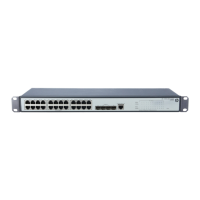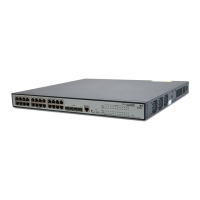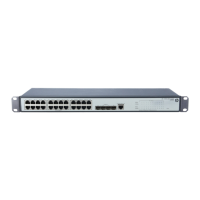218
With CDP compatibility enabled, your device can receive and recognize CDP packets from a Cisco IP
phone and respond with CDP packets, which carry the voice VLAN configuration TLVs. The voice traffic
is confined in the configured voice VLAN, and differentiated from other types of traffic.
CDP-compatible LLDP operates in one of the following modes:
TxRx: CDP packets can be transmitted and received.
Disable: CDP packets cannot be transmitted or received.
Protocols and standards
IEEE 802.1AB-2005, Station and Media Access Control Connectivity Discovery
ANSI/TIA-1057, Link Layer Discovery Protocol for Media Endpoint Devices
Configuring LLDP
LLDP configuration task list
Perform the tasks in Table 94 to configure LLDP:
Table 94 LLDP configuration task list
Task Remarks
Enabling LLDP on ports
Optional
By default, LLDP is enabled on ports.
Make sure that LLDP is also enabled globally, because LLDP can work on a port
only when it is enabled both globally and on the port.
Configuring LLDP settings
on ports
Optional
LLDP settings include LLDP operating mode, packet encapsulation, CDP
compatibility, device information polling, trapping, and advertised TLVs.
By default,
The LLDP operating mode is TxRx.
The encapsulation format is Ethernet II.
CDP compatibility is disabled.
Device information polling and trapping are disabled.
All TLVs except the Location Identification TLV are advertised.
Configuring global LLDP
setup
Required
By default, global LLDP is disabled.
To enable LLDP to work on a port, enable LLDP both globally and on the port.
Displaying LLDP
information for a port
Optional
You can display the local LLDP information, neighbor information, statistics, and
status information of a port, where
The local LLDP information refers to the TLVs to be advertised by the local
device to neighbors.
The neighbor information refers to the TLVs received from neighbors.
Displaying global LLDP
information
Optional
You can display the local global LLDP information and statistics.

